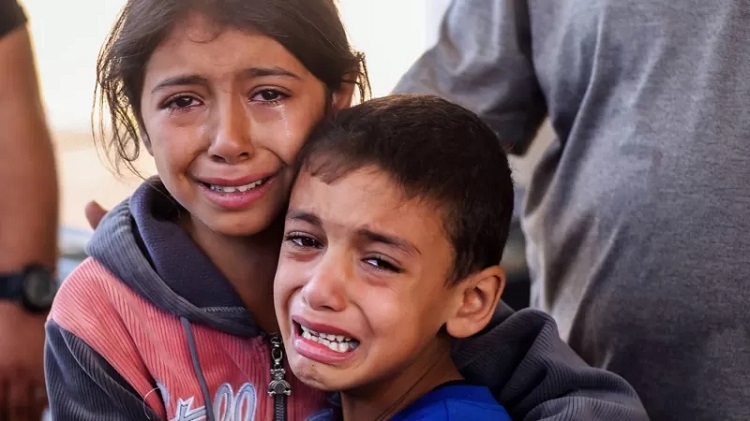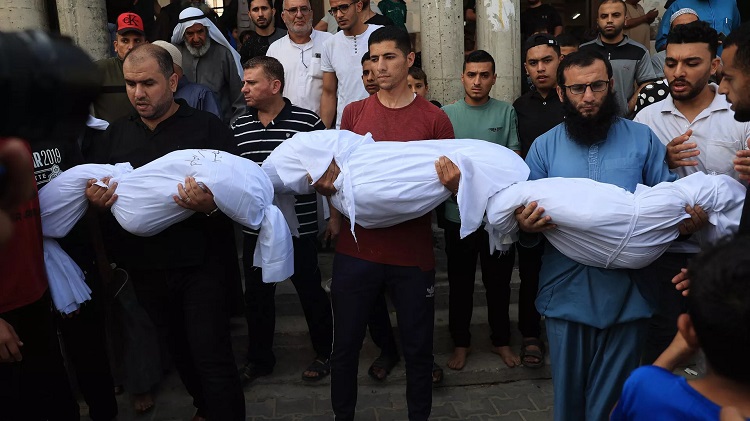The number of children affected by the conflict in the Gaza Strip continues to increase. More than 3,000 died in the bombings, thousands more are missing or in captivity, and more than a million lack access to water, food and other basic necessities.
 Photo: Getty Images
Photo: Getty Images
Gaza has become a “graveyard” for children, a UNICEF official said this Tuesday, reporting that more than 3,400 children died in the bombings and more than a million face severe lack of basic needs and lifelong trauma.
For his part, the person responsible for coordinating humanitarian aid at the UN, Martin Griffiths, who visited Israel and the occupied Palestinian territories days ago, called Gaza families from East Jerusalem and said what they had suffered for since the beginning of Israel’s retaliation to the deadly Hamas attacks of October 7th were “more than devastating”.
“When an eight-year-old girl tells you she doesn’t want to die, it’s hard not to feel helpless,” she wrote on the social platform X, formerly known as Twitter.
Children buried under rubble
“According to reports, more than 3,450 children have already died. What is astonishing is that this number is increasing significantly every day. Gaza has become a children’s cemetery. “For everyone else it’s hell,” said James Elder, spokesman for the United Nations Children’s Fund (UNICEF), in Geneva on Tuesday.
Thousands more children have been reported missing and may be trapped under the rubble or dead, awaiting rescue or recovery, the United Nations Office for the Coordination of Humanitarian Affairs (OCHA) said.
Her spokesman JensLaerke said it was “almost unbearable to think of children buried under rubble with little chance of getting them out.”
Decades of trauma lie ahead
“The threats go beyond bombs and mortar shells,” emphasized UNICEF’s James Elder. The death of children from dehydration is “a growing threat” in the enclave as water production in Gaza is at 5% of required levels due to malfunctioning, damaged or missing fuel.
When the fighting finally stops, the cost to children “will be felt for decades” because of the horrific trauma faced by survivors, he said.
 Photo: Said Khatib / AFP
Photo: Said Khatib / AFP
Elder gave the example of the four-year-old daughter of a UNICEF worker in Gaza who began self-harming due to daily stress and fear, while her mother told her colleagues, “I can’t afford to think about it.” Um To ensure my children’s mental health, I have to keep them alive first.”
A humanitarian ceasefire is essential
Elder reiterated his calls “on behalf of the 1.1 million children in Gaza who live in this nightmare” for an immediate humanitarian ceasefire and the opening of all entry points to permanent humanitarian access. “If we had a 72-hour ceasefire, this would mean a thousand children would be safe again this time,” he said.
The families of the hostages are living in great distress
On Monday, Griffiths also met in Jerusalem with relatives of some of the more than 230 hostages held in Gaza since October 7. Around 30 of the hostages are believed to be children.
The U.N. aid director said that these families have been “living in agony in recent weeks, not knowing whether their loved ones are alive or dead,” and that he “couldn’t even begin to imagine” what they were going through.
The United Nations has repeatedly called for the immediate and unconditional release of the hostages.
According to OCHA’s JensLaerke, a total of 26 trucks carrying humanitarian aid entered the Gaza Strip on Monday through the Rafah border crossing with Egypt, in the hope that more would arrive. This brings the total number of trucks allowed to cross the border crossing between October 21st and 30th to 143.
The OCHA spokesman stressed that while the increase in the volume of aid entering Gaza in the last two days was welcome, “current amounts represent only a fraction of what is needed to prevent further deterioration of the already serious situation.” “To prevent humanitarian situations, including civil ones.” UnrestW.
Before the conflict escalated, nearly 500 trucks, both commercial and humanitarian, entered the enclave every working day, including around 50 tankers.
In a briefing to the U.N. Security Council on Monday, Griffiths spoke of the urgency of replenishing fuel supplies, “critical to powering essential services, including hospitals and water desalination plants, and to moving humanitarian supplies within the Gaza Strip.”
Attacks on healthcare
The public health disaster in the enclave is compounded by attacks on healthcare. The UN health agency (WHO) said it had documented 82 such attacks in Gaza.
OCHA warned that the surrounding areas of two hospitals in the city and northern Gaza Strip were reportedly shelled for a second consecutive day on Monday, prompting Griffiths to tell the Security Council his concerns about “reports of military installations near hospitals and… “To communicate a request from Israeli authorities to evacuate hospitals, including Al Quds and Shifa.”
In response to a question about these allegations, UN Human Rights Office (OHCHR) spokeswoman Liz Throssell reiterated on Tuesday that hospitals are buildings protected by international humanitarian law. If proven, the use of human shields in hospitals would constitute a war crime. However, “regardless of the actions of one side, such as the use of hospitals for military purposes, the other side must comply with international humanitarian standards for the conduct of hostilities,” which provide special protection to medical units at all times, he stressed.
In the event that medical units lose their special protection because they were used outside their humanitarian function to commit harmful acts against the enemy, and if the warning to stop harmful use was not heeded, “any attack must still be complied with. “The principles of attack preparedness and proportionality,” explained Throssell.
(Taken from UN News)

